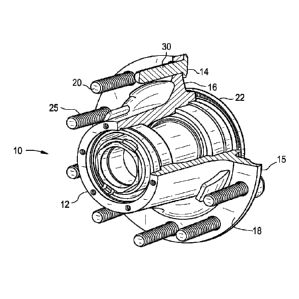Une partie des informations de ce site Web a été fournie par des sources externes. Le gouvernement du Canada n'assume aucune responsabilité concernant la précision, l'actualité ou la fiabilité des informations fournies par les sources externes. Les utilisateurs qui désirent employer cette information devraient consulter directement la source des informations. Le contenu fourni par les sources externes n'est pas assujetti aux exigences sur les langues officielles, la protection des renseignements personnels et l'accessibilité.
L'apparition de différences dans le texte et l'image des Revendications et de l'Abrégé dépend du moment auquel le document est publié. Les textes des Revendications et de l'Abrégé sont affichés :
| (12) Brevet: | (11) CA 3084485 |
|---|---|
| (54) Titre français: | SYSTEME DE RETENUE DE ROUE |
| (54) Titre anglais: | WHEEL RETENTION SYSTEM |
| Statut: | Octroyé |
| (51) Classification internationale des brevets (CIB): |
|
|---|---|
| (72) Inventeurs : |
|
| (73) Titulaires : |
|
| (71) Demandeurs : |
|
| (74) Agent: | GOWLING WLG (CANADA) LLP |
| (74) Co-agent: | |
| (45) Délivré: | 2022-04-26 |
| (86) Date de dépôt PCT: | 2018-10-25 |
| (87) Mise à la disponibilité du public: | 2019-05-02 |
| Requête d'examen: | 2020-04-22 |
| Licence disponible: | S.O. |
| (25) Langue des documents déposés: | Anglais |
| Traité de coopération en matière de brevets (PCT): | Oui |
|---|---|
| (86) Numéro de la demande PCT: | PCT/US2018/057537 |
| (87) Numéro de publication internationale PCT: | WO2019/084281 |
| (85) Entrée nationale: | 2020-04-22 |
| (30) Données de priorité de la demande: | ||||||
|---|---|---|---|---|---|---|
|
L'invention concerne un système de retenue de roue conçu pour retenir une roue sur un véhicule. Le système comprend une pluralité d'ouvertures de réception de connecteur dans une bride de moyeu de roue, chaque bride de moyeu de roue comprenant une butée de boulon surélevée au niveau de chaque ouverture de réception de boulon. Une pluralité de connecteurs filetés ou de boulons sont prévus, chaque boulon étant reçu dans l'une des ouvertures de réception de boulon. Chaque boulon a une tête avec une surface aplatie ou clipsée qui s'engrène avec la butée de boulon surélevée dans chaque ouverture de réception de boulon sur la bride de moyeu de roue. Les butées de boulon surélevées de l'invention empêchent par liaison de force les boulons de tourner dans les ouvertures.
A wheel retention system is provided for retaining a wheel on a vehicle. The system includes a plurality of connector receiving openings in a wheel hub flange, with each wheel hub flange including a raised bolt stop at each bolt receiving opening. A plurality of threaded connectors or bolts is provided, with each bolt received in one of the bolt receiving openings. Each bolt has a head with a flattened or clipped surface that meshes with the raised bolt stop in each bolt receiving opening on the wheel hub flange. These raised bolt stops positively prevent the bolts from rotating in the openings.
Note : Les revendications sont présentées dans la langue officielle dans laquelle elles ont été soumises.
Note : Les descriptions sont présentées dans la langue officielle dans laquelle elles ont été soumises.

Pour une meilleure compréhension de l'état de la demande ou brevet qui figure sur cette page, la rubrique Mise en garde , et les descriptions de Brevet , États administratifs , Taxes périodiques et Historique des paiements devraient être consultées.
| Titre | Date |
|---|---|
| Date de délivrance prévu | 2022-04-26 |
| (86) Date de dépôt PCT | 2018-10-25 |
| (87) Date de publication PCT | 2019-05-02 |
| (85) Entrée nationale | 2020-04-22 |
| Requête d'examen | 2020-04-22 |
| (45) Délivré | 2022-04-26 |
Il n'y a pas d'historique d'abandonnement
Dernier paiement au montant de 210,51 $ a été reçu le 2023-09-20
Montants des taxes pour le maintien en état à venir
| Description | Date | Montant |
|---|---|---|
| Prochain paiement si taxe générale | 2024-10-25 | 277,00 $ |
| Prochain paiement si taxe applicable aux petites entités | 2024-10-25 | 100,00 $ |
Avis : Si le paiement en totalité n'a pas été reçu au plus tard à la date indiquée, une taxe supplémentaire peut être imposée, soit une des taxes suivantes :
Les taxes sur les brevets sont ajustées au 1er janvier de chaque année. Les montants ci-dessus sont les montants actuels s'ils sont reçus au plus tard le 31 décembre de l'année en cours.
Veuillez vous référer à la page web des
taxes sur les brevets
de l'OPIC pour voir tous les montants actuels des taxes.
| Type de taxes | Anniversaire | Échéance | Montant payé | Date payée |
|---|---|---|---|---|
| Enregistrement de documents | 2020-04-22 | 100,00 $ | 2020-04-22 | |
| Le dépôt d'une demande de brevet | 2020-04-22 | 400,00 $ | 2020-04-22 | |
| Requête d'examen | 2023-10-25 | 800,00 $ | 2020-04-22 | |
| Taxe de maintien en état - Demande - nouvelle loi | 2 | 2020-10-26 | 100,00 $ | 2020-09-18 |
| Taxe de maintien en état - Demande - nouvelle loi | 3 | 2021-10-25 | 100,00 $ | 2021-09-21 |
| Taxe finale | 2022-03-30 | 305,39 $ | 2022-02-02 | |
| Taxe de maintien en état - brevet - nouvelle loi | 4 | 2022-10-25 | 100,00 $ | 2022-09-22 |
| Taxe de maintien en état - brevet - nouvelle loi | 5 | 2023-10-25 | 210,51 $ | 2023-09-20 |
Les titulaires actuels et antérieures au dossier sont affichés en ordre alphabétique.
| Titulaires actuels au dossier |
|---|
| CONSOLIDATED METCO, INC. |
| Titulaires antérieures au dossier |
|---|
| S.O. |